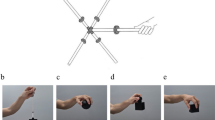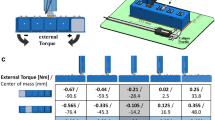Abstract
When accepting a parcel from another person, we are able to use information about that person’s movement to estimate in advance the weight of the parcel, that is, to judge its weight from observed action. Perceptual weight judgment provides a powerful method to study our interpretation of other people’s actions, but it is not known what sources of information are used in judging weight. We have manipulated full form videos to obtain precise control of the perceived kinematics of a box lifting action, and use this technique to explore the kinematic cues that affect weight judgment. We find that observers rely most on the duration of the lifting movement to judge weight, and make less use of the durations of the grasp phase, when the box is first gripped, or the place phase, when the box is put down. These findings can be compared to the kinematics of natural box lifting behaviour, where we find that the duration of the grasp component is the best predictor of true box weight. The lack of accord between the optimal cues predicted by the natural behaviour and the cues actually used in the perceptual task has implications for our understanding of action observation in terms of a motor simulation. The differences between perceptual and motor behaviour are evidence against a strong version of the motor simulation hypothesis.



Similar content being viewed by others
References
Atkeson CG, Hollerbach JM (1985). Kinematic features of unrestrained vertical arm movements. J Neurosci 5:2318–2330
Bekkering H, Wohlschlager A, Gattis M (2000) Imitation of gestures in children is goal-directed. Q J Exp Psychol A 53:153–164
Bingham GP (1987) Kinematic form and scaling: further investigations on the visual perception of lifted weight. J Exp Psychol Hum Percept Perform 13:155–177
Cutting JE, Kozlowski LT (1977) Recognizing friends by their walk: gait perception without familiarity cues. Bull Psychon Soc 9:353–356
Decety J, Grezes J (1999) Neural mechanisms subserving the perception of human actions. Trends Cogn Sci 3:172–178
Fagioli S, Hommel B, Schubotz RI (2005) Intentional control of attention: action planning primes action-related stimulus dimensions. Psychol Res (this issue)
Flanagan JR, Johansson RS (2003) Action plans used in action observation. Nature 424:769–771
Gallese V, Goldman A (1998) Mirror neurons and the simulation theory of mind-reading. Trends Cogn Sci 2:493–501
Gallese V, Fadiga L, Fogassi L, Rizzolatti G (1996) Action recognition in the premotor cortex. Brain 119:593–609
Gallese V, Keysers C, Rizzolatti G (2004) A unifying view of the basis of social cognition. Trends Cogn Sci 8:396–403
Gordon AM, Forssberg H, Johansson RS, Westling G (1991) Visual size cues in the programming of manipulative forces during precision grip. Exp Brain Res 83:477–482
Grafton ST, Arbib MA, Fadiga L, Rizzolatti G (1996) Localization of grasp representations in humans by positron emission tomography. 2. Observation compared with imagination. Exp Brain Res 112:103–111
Grezes J, Frith CD, Passingham RE (2004) Inferring false beliefs from the actions of oneself and others: an fmri study. Neuroimage 21:744–750
Hamilton A, Wolpert DM, Frith U (2004) Your own action influences how you perceive another person’s action. Curr Biol 14:493–498
Hommel B, Musseler J, Aschersleben G, Prinz W (2001) The theory of event coding (TEC): a framework for perception and action planning. Behav Brain Sci 24: 849–878
Howell D (2001) Statistical methods for psychology, 5th edn. Pacific Grove, Duxbury
Johansson G (1973) Visual perception of biological motion and a model for its analysis. Percept Psychophys 14:201–211
Johansson RS, Westling G (1988) Coordinated isometric muscle commands adequately and erroneously programmed for the weight during lifting task with precision grip. Exp Brain Res 71:59–71
Jokisch D, Troje NF (2003) Biological motion as a cue for the perception of size. J Vis 3:252–264
Kozlowski LT, Cutting JE (1977) Recognizing the sex of a walker from a dynamic point-light display. Percept Psychophys 21:575–580
Rizzolatti G, Craighero L (2004) The mirror-neuron system. Annu Rev Neurosci 27:169–192
Runeson S, Frykholm G (1983) Kinematic specification of dynamics as an informational basis for person-and-action perception: expectation, gender recognition, and deceptive intention. J Exp Psychol Gen 112:585–615
Runeson S, Frykholm G (1981) Visual perception of lifted weight. J Exp Psychol Hum Percept Perform 7:733–740
Shim J, Carlton LG (1997) Perception of kinematic characteristics in the motion of lifted weight. J Motor Behav 29:131–146
Tomasello M, Call J (1997) Primate cognition. Oxford University Press, Oxford
Weir PL, MacKenzie CL, Marteniuk RG, Cargoe SL, Frazer MB (1991) The effects of object weight on the kinematics of prehension. J Motor Behav 23:192–204
Acknowledgements
This work was funded by the McDonnell Foundation, the Wellcome Trust and Riken Institute, Japan. We would like to thank James Ingram for computer support.
Author information
Authors and Affiliations
Corresponding author
Additional information
A. F. de C. Hamilton and D. W. Joyce have contributed equally to this work.
Rights and permissions
About this article
Cite this article
de C. Hamilton, A.F., Joyce, D.W., Flanagan, J.R. et al. Kinematic cues in perceptual weight judgement and their origins in box lifting. Psychological Research 71, 13–21 (2007). https://doi.org/10.1007/s00426-005-0032-4
Received:
Accepted:
Published:
Issue Date:
DOI: https://doi.org/10.1007/s00426-005-0032-4




